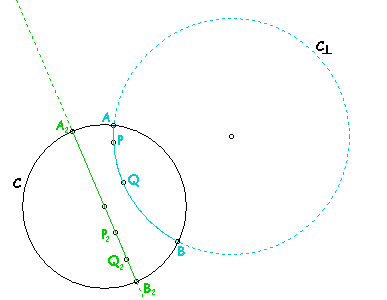
8.2 The Poincaré Disk
Model:
To develop the Poincaré disk model, consider a fixed circle,
C, in a Euclidean plane. We assume, without loss of generality, that
the radius of C is 1, and that its center is at the origin of the Euclidean
plane.

Figure 8.1: Lines in the disk model.
Let C⊥ be any circle which is orthogonal to circle C. Two circles are orthogonal when their tangents at each intersection point are perpendicular. In the following discussion, D-points, D-lines, etc. are used to identify how points, lines, etc. are defined in the disk model.
D-points: D-points are Euclidean points of the interior of C. Let Ω denote the set of all D-points.
D-lines: A D-line is either (1) the intersection of Ω and C⊥, or (2) the intersection of Ω and a diameter of C.
D-lines, defined in this way, are consistent with the axioms of Hyperbolic
Geometry. One of the axioms of Hyperbolic Geometry states that every
two D-points lie on exactly one D-line. By trying a few sketches
on paper, you can get an intuitive feel for why this axiom is upheld by
the above definition of D-lines. Appendix A
shows how to find the Euclidean equation of circle unlikely determined
by any two D-points. Another axiom of HG is: "Any line segment
with given endpoints may be continued in either direction". This
axiom is satisfied even though the points in the disk model are bounded
by the unit circle. Notice that D-lines form open intervals (D-points
may be arbitrarily close to C, but may not actually be on C). Therefore,
no matter now close an endpoint is to C, it can always be made a little
closer.
The disk model also includes a distance function. Before stating this function, consider what properties it must satisfy:

A formal development of this function, and proof that it satisfies the
criteria listed above can be found in E.E. Moise's "Elementary Geometry
from an Advanced Standpoint" [Moise-74].
D-circles: A D-circle is defined as the set of all D-points that are equal D-distance from a given D-point.
D-angle measure: Given three D-points, A, B, and C, construct the Euclidean rays BA' and BC' that are tangent to D-lines BA and BC at point B (see figure 8.2). The measure of D-angle, ∠ABC, is defined as equal to the measure of Euclidean angle, ∠A'BC'.

8.3 The Upper Half-Plane Model:
To develop the Upper Half-Plane model, consider a fixed line, ST, in
a Euclidean plane. We assume, without loss of generality, that ST
is on the x-axis of the Euclidean plane.
H-points: H-points are Euclidean points on one side of line
ST. Let Ψ denote the set of all H-points.
H-lines: An H-line is either (1) a semicircle within Ψ, and with center on ST, or (2) the intersection of Ψ and a perpendicular to ST.

Figure 8.3: Lines in the Upper Halp-Plane Model.
H-distance: Let P and Q denote two H-points. If the unique H-line that passes through these two points is a semicircle, then the H-line approaches the boundary line, ST, in two Euclidean points, A and B, and the distance between P and Q, d(PQ), is given by equation 8.3.1. If the unique H-line that passes through these two points is a line, then the H-line approaches the boundary line, ST, in one Euclidean points, A2, and the distance between P and Q, d(PQ), is given by equation 8.3.2. In both equations 8.3.1 and 8.3.2, Let |PA|, etc. denote the Euclidean distances from point P to A, etc. Let Ln denote the natural logarithm.
 (8.3.1)
(8.3.1)  (8.3.2)
(8.3.2)H-circles: A H-circle is defined as the set of all H-points that are equal H-distance from a given H-point.
H-angle measure: Given three H-points, A, B, and C, construct the Euclidean rays BA' and BC' that are tangent to D-lines BA and BC at point B (see figure 8.4). The measure of H-angle, ∠ABC, is defined as equal to the measure of Euclidean angle, ∠A'BC'.

Solution: Let (Xo,Yo) be the coordinates of the center of C⊥, and let r⊥ be the radius. Since the two points P and Q lie on C⊥, we have the following two equations:
 (equation A.1)
(equation A.1)
 (equation A.2)
(equation A.2)Since the two circles are orthogonal, the line segment joining the two centers forms the hypotenuse of a right triangle with one leg a radius of C and the other a radius of C⊥. Thus, the Pythagorean theorem gives:
 (equation A.3)
(equation A.3)Expending equation A.1 and using equation A.3 gives:
 (equation A.4)
(equation A.4)
Expending equation A.2 and using equation A.3 gives:
 (equation A.5)
(equation A.5)Equations A.4 and A.5 are linear equations in Xo and Yo since the other variables are fixed. There will be a solution when the determinant of coefficients is non zero, that is, if and only if:
is non zero. The determinant is not zero if and only if the two points lie on a line through the origin (a diameter of C). When the two points, P and Q, do not lie on a diameter of C, equations A.4 and A.5 can be easily solved to give the center (Xo,Yo) of the orthogonal circle.
![]() NonEuclid Home
NonEuclid Home
![]() Next Topic - For The Teacher: Why is it Important for Students to Study Hyperbolic Geometry
Next Topic - For The Teacher: Why is it Important for Students to Study Hyperbolic Geometry
Copyright©: Joel Castellanos, 1994-2002